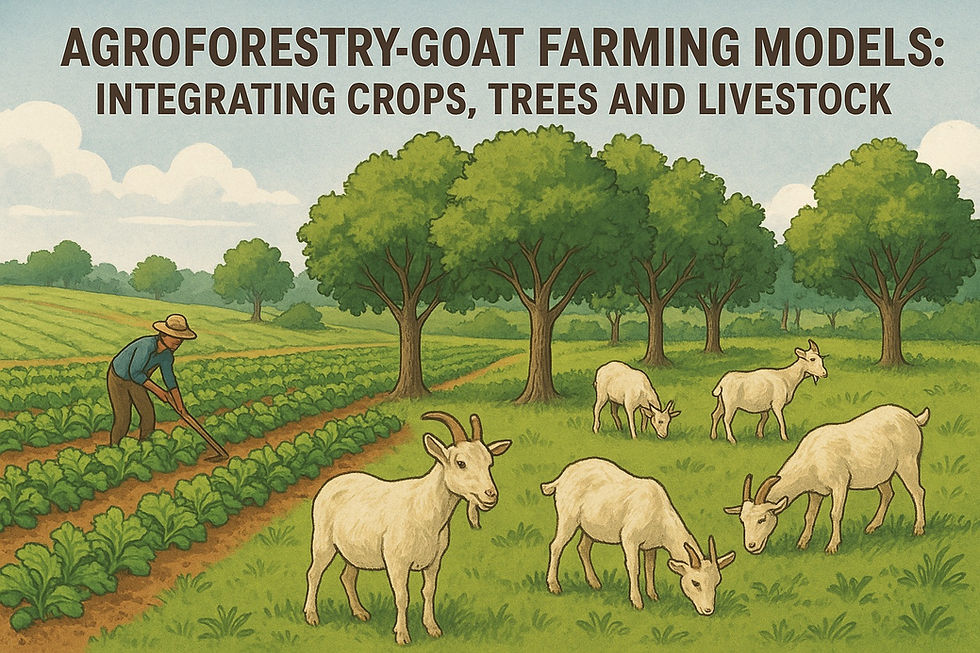Assam’s Livestock Revolution: Fueling the Rural Economy through Goat Farming
- Global Services TGT
- Jun 24
- 3 min read
Updated: Jun 26
In the rural heartlands of Assam, a quiet revolution is underway—led not by tractors or large-scale industries, but by humble goats popularly known as the poor man's cow. Often overlooked in mainstream agricultural discourse, goat farming has emerged as a key driver of rural livelihoods, income diversification, and women’s empowerment in the state. With low input requirements, climate resilience, and strong local demand, goats are powering what many are calling Assam’s livestock revolution.
Assam’s agrarian economy is dominated by smallholder and marginal farmers. Over 85% of livestock farmers rear goats as a traditional, low-risk livelihood. With fragmented landholdings, frequent floods, and fluctuating crop incomes, goats offer a viable economic buffer.
Goat farming is especially prominent in districts like Barpeta, Goalpara, Dhubri, and Nagaon, where ethnic communities have practiced backyard goat rearing for generations.
Why Goat Farming is Booming in Assam
· High Demand and Cultural Acceptance: Goat meat (chevon) is widely consumed across Assam and the broader North East. It holds ceremonial and culinary value, ensuring year-round demand and premium pricing. The state imports a large portion of its meat from Bihar and West Bengal, creating a huge opportunity for local farmers.
· Low Investment, Quick Returns: Compared to cattle or buffalo, goats require lower capital and adapt easily to available local feed resources. With a short gestation period and fast multiplication, even a small herd of 4–6 goats can significantly supplement household income within a year.
· Women-Led Livelihoods: In Assam, goat farming is largely women-managed. SHGs (Self-Help Groups) and rural women entrepreneurs have embraced goat rearing as a part-time yet profitable venture. Many micro-credit programs now promote goat-based enterprises among rural women.
· Climate Resilience: Goats are hardy animals that can thrive in diverse ecological zones, from flood-prone plains to hilly terrains. Their ability to survive on crop residues, shrubs, and kitchen waste makes them ideal for Assam’s changing climate and resource constraints.
Key Drivers of the Goat Farming Movement
Government and NGO Support: Assam Livestock and Poultry Corporation, NABARD and various NGOs have introduced goat breeding units, AI programs and capacity-building sessions. Schemes like the Assam Rural Livestock Mission and targeted support under NRLM are boosting institutional backing.
Rise of Community-Based Models: Community goat banks, revolving livestock schemes, and SHG-led rearing clusters are scaling up goat production while reducing risks. These models also enable collective insurance, healthcare access, and bulk marketing.
Training and Breed Improvement: Farmers are now being trained in improved shed design, preventive healthcare, and scientific feeding. Indigenous breeds like Assam Hill Goat are being promoted alongside crossbreeding efforts for higher productivity.
Challenges that Still Remain
Veterinary Gaps: Many rural blocks lack functional vet Centers and sub-centers or timely health services for goats.
Market Access: Local farmers often sell goats to middlemen at low prices due to a lack of aggregation, transport, and direct buyer linkages.
Flood Impact: Recurrent flooding damages livestock infrastructure and increases disease risk.
Feed and Fodder Shortage: No organized fodder cultivation programs exist for goats, small ruminant,s especially in char and tribal areas.
Way Forward: Scaling the Revolution
Village-Level Goat Hubs: Create decentralized goat rearing clusters with common breeding bucks, para-vets, and feed banks.
Fodder Development Plans: Integrate fodder crop cultivation into flood-free areas and homestead gardens.
Women-Centric Models: Promote SHG-led goat farming microenterprises with access to credit, insurance, and technical support.
Digital Extension & Market Linkages: Use mobile-based advisories, e-market platforms, and community radio to spread awareness and market information.
Assam’s growing focus on goat farming reflects a larger shift in rural development strategy—from dependence on monsoon crops to resilient, livestock-based livelihoods. If properly supported through policy, infrastructure, and training, goat farming can unlock a new era of rural prosperity, especially for smallholders and women in Assam’s villages. The revolution has begun—now it’s time to scale it.



Comments